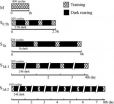Discovery of a new mechanism of gene control that is associated with cancer
Scientists at Memorial Sloan-Kettering Cancer Center in New York and at IRB Barcelona reveal the mechanism of action of a protein that is essential for life and is associated with disease.
2011-06-19
(Press-News.org) Researchers headed by Joan Massagué at Memorial Sloan-Kettering Cancer Center (MSKCC) in New York and by María Macías at the Institute for Research in Biomedicine (IRB Barcelona) have identified a complex mechanism by which some proteins that are essential for life, called Smads, regulate the activity of genes associated with cancer. The fruit of three years of intense work, the study reports on the life cycle of this protein, a process that ensures that the protein is destroyed when it has completed its function. These results have been published today in the top journal Genes & Development, which has devoted its cover to this research.
In the TGF-beta/Smad signal cascade, the hormones TGF-beta and BMP transmit information to the Smad protein in the cell nucleus in order for this molecule to stop cell division and to ensure that tissues grow in an orderly and coordinated manner. Although the TGF-beta/Smad signalling pathway has been known for over twenty years, until now it was unclear how Smads temporally controlled the activity of such important genes. "We had several pieces of the puzzle but we couldn't put them together", says Macías.
A number of earlier studies performed by Massagué's lab had identified that Smads undergo phosphorylations –a kind of chemical change – in a region of the protein about which little is known. By means of biophysical and biochemical approaches, the researchers have discovered that these modifications occur in a coordinated fashion over time and are not random. "First, phosphorylations make some proteins bind to Smads in order to control the activity of target genes and later other phoshorylations cause protein bindings that lead to the destruction of Smad once this protein has completed its mission. This is the way cells prevent fatal errors", explains Macías.
Having established the time sequence of these events, the scientists used cell and structural biology approaches –determination of the atom position in Smad proteins and other activating and destructor proteins bound to them– to confirm the results previously found. "We have been able to decipher the specificity of the binding between Smad and other proteins and to reveal the secret code that these proteins use to extract information".
How do these proteins favour tumour cells? Massagué explains that "these signalling cascades are like the body's pólice force. The tumour cells, in other words the delinquents, disturb these pathways and use them for their own means to grow and spread". These pathways normally are involved in basic cell processes but when altered by mutations several diseases can appear such as cancer, congenital conditions, chronic inflammation and emphysema. These results could serve as the foundation on which to develop new clinical treatments against cancer and other diseases.
INFORMATION:
Reference article:
A Smad action-turnover switch operated by WW domain readers of a phosphoserine code.
Eric Aragón, Nina Goerner, Alexia-Ileana Zaromytidou, Qiaoran Xi, Albert Escobedo, Joan Massagué, and Maria J. Macias. Genes & Development (2011). [doi: 10.1101/gad.2060811]
END
ELSE PRESS RELEASES FROM THIS DATE:
2011-06-19
Scientists and educators alike have long known that cramming is not an effective way to remember things. With their latest findings, researchers at the RIKEN Brain Science Institute in Japan, studying eye movement response in trained mice, have elucidated the neurological mechanism explaining why this is so. Published in the Journal of Neuroscience, their results suggest that protein synthesis in the cerebellum plays a key role in memory consolidation, shedding light on the fundamental neurological processes governing how we remember.
The "spacing effect", first discovered ...
2011-06-19
A compound that for about 60 years has been used as a drug against tapeworm infection is also apparently effective against colon cancer metastasis, as studies using mice have now shown. The compound silences a gene that triggers the formation of metastases in colon cancer. Professor Ulrike Stein (Experimental and Clinical Research Center, a joint cooperation between the Charité Medical Faculty and the Max Delbrück Center for Molecular Medicine, (MDC)) and her research group made this discovery in collaboration with Professor Robert H. Shoemaker of the National Cancer Institute ...
2011-06-19
VIDEO:
A movie of the encounter made by combining 100 images of the June 1, 2011 Phobos–Jupiter conjunction. The High Resolution Stereo Camera on Mars Express took this sequence.
Click here for more information.
Earlier this month, ESA's Mars Express performed a special manoeuvre to observe an unusual alignment of Jupiter and the martian moon Phobos. The impressive images have now been processed into a movie of this rare event.
At the moment when Mars Express, Phobos, and ...
2011-06-19
The post-war trend of falling birth rates has been reversed across Europe, according to a new study. However, despite an increasing emphasis on family and fertility policies in Europe, this recent development involves social, cultural and economic factors more than individual policy interventions.
For some decades, couples have been having children later in life. But birth-rates among younger women have stabilised and the long-term trend towards lower fertility rates has been reversed.
Politicians are still left to grapple with problems associated with an ageing population ...
2011-06-19
It pays to prevent fractures. That's one of the main findings of a landmark report 'Osteoporosis – Burden, Healthcare provision and Opportunities in the European Union' newly published in the journal Archives of Osteoporosis. The study, compiled by the International Osteoporosis Foundation (IOF) in collaboration with the European Federation of the Pharmaceutical Industries and Associations (EFPIA), calculates the future burden of fractures as a consequence of increasing treatment uptake in the five largest European countries as well as Sweden.
Fragility fractures, which ...
2011-06-19
The U.S. Medicaid program is likely paying far more than necessary for medications and not offering patients the most effective ones available, by ignoring international evidence-based lists of safe and effective medications, according to a new study by researchers at University of California, San Francisco.
The study, which compared the Medicaid program's Preferred Drug Lists in 40 states nationwide against the World Health Organization's 2009 Essential Medicines List, found that the medications that are automatically paid for by the state-run Medicaid programs vary ...
2011-06-19
LOUISVILLE, Ky. – The first three patients to undergo an investigational surgical procedure for peripheral vascular disease that involves the patient's own stem cells continue to do well, reports the University of Louisville surgeon who is the principal investigator.
The "TGI-PVG IDE" clinical trial initiated at UofL involves using a patient's own stem cells to line man-made bypass grafts to better the chances at saving the limbs of patients with peripheral artery disease. Charles B. Ross, M.D., chief of the Division of Vascular Surgery and Endovascular Therapeutics, ...
2011-06-19
The first six of 18 segments that will form NASA's James Webb Space Telescope's primary mirror for space observations completed final cryogenic testing this week. The ten week test series included two tests cycles where the mirrors were chilled down to -379 degrees Fahrenheit, then back to ambient temperature to ensure the mirrors respond as expected to the extreme temperatures of space.
A second set of six mirror assemblies will arrive at Marshall in late July to begin testing, and the final set of six will arrive in the fall.
The X-ray and Cryogenic Facility at NASA's ...
2011-06-19
When you are considering breast augmentation it is common to wonder how long the implants will last. Stories abound about leaking implants and implant ruptures, causing some women to seriously consider if this procedure is safe and long lasting. It is important to remember that no medical device can last a lifetime. Like all medical devices, breast implants can, over time, wear down and require replacement.
Why Breast Implants Fail
A majority of breast implants last for ten to 25 years. Some women may enjoy a longer lifespan and others may have to replace their breast ...
2011-06-19
A low pressure area in the Eastern Pacific Ocean, located off the western coast of Mexico, is still getting organized, and System 92E and the Tropical Rainfall Measuring Mission (TRMM) satellite spotted heavy rain and strong thunderstorms within.
On Friday, June 17, 2011, System 92E appeared on satellite imagery as a broad area of low pressure that contained showers and thunderstorms. System 92E was located several hundred miles south of the Gulf of Tehuantepec. The gulf is a large area at 16 North and 95 West, which is right where the low pressure area is centered. Many ...
LAST 30 PRESS RELEASES:
[Press-News.org] Discovery of a new mechanism of gene control that is associated with cancer
Scientists at Memorial Sloan-Kettering Cancer Center in New York and at IRB Barcelona reveal the mechanism of action of a protein that is essential for life and is associated with disease.



